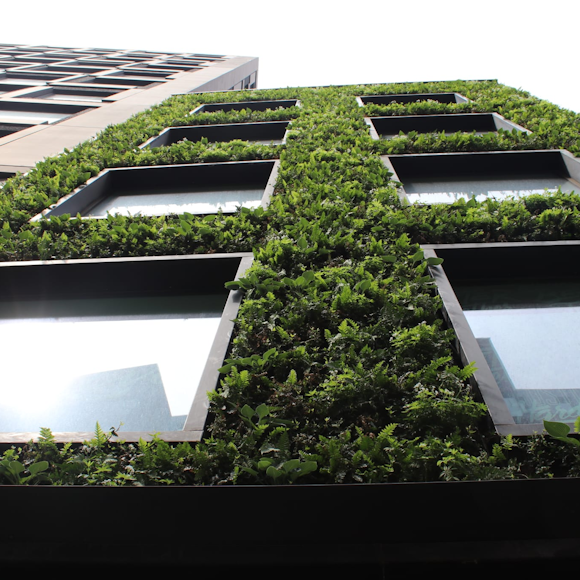As developers, designers and land managers try to meet the new biodiversity net gain mandate, in this blog we will break down everything you need to know about it, including how you can go beyond simple compliance, using our internationally recognised living walls.
Biodiversity net gain is being implemented to preserve nature by making sure that developments benefit biodiversity rather than harm it. It means that to obtain planning permission, most construction projects need to demonstrate a 10% increase in habitat biodiversity.
What is Biodiversity Net Gain?
Biodiversity net gain (BNG) is a strategy to aid in the restoration of nature while utilising land for development. It is ensuring that the creation of wildlife habitat is left in a better condition than it was prior to development.
Unless exempt, this will apply to developments under the Town and Country Planning Act 1990 beginning in November 2023.
Is Biodiversity Net Gain Mandatory?
Except for small sites and exemptions, we anticipate the mandatory requirement taking effect in November 2023. There would be a 2-year implementation period for obligatory BNG, according to the Government's answer to the 2018 consultation on net gain.
The time for small sites to change has been extended to April 2024. This gives developers and planning authorities more time to prepare for lots of small application requests.
How is biodiversity net gain measured?
The Biodiversity Metric is used to calculate BNG. This is a tool used by qualified individuals, such as ecologists. It compares the habitat present on a location before and after development by using changes in the size and quality of habitats as a proxy for nature. This comparison is based on four major factors: habitat size, condition, uniqueness, and location.
Biodiversity at the heart of Viritopia
Nature is at the heart of everything we design and create. We use nature's power inside our systems to develop something that can be integrated into many projects both inside and out. Key elements to all our projects are the use of natural soil and live plants, which helps us not only improve air quality, and well-being, but biodiversity.
Long before there were talks of the now mandatory BNG, we put biodiversity at the center of everything we do – take a look at how we have improved both the biodiversity and air quality, by installing living walls on a building in the heart of Shoreditch, London.
As promised, we are going to show you how you can accomplish your BNG using some of our trustworthy techniques.
Using Urban Green Infrastructure to Achieve Biodiversity Net Gain
Green infrastructure (GI) is a system of multipurpose green areas and other green elements, both in urban and rural areas, that can enhance a community's quality of life and help the environment. It includes parks, open spaces, playing fields, woodlands – and also street trees, allotments, private gardens, green roofs and walls, sustainable drainage systems (SuDS) and soils.
To better understand how we incorporate green infrastructure to achieve BNG, we have segmented it into 3 key components to our solutions:
- Soil
- Longevity
- Maintenance
Soil
One crucial component to achieving the required BNG, also vital to the habitat's success, is soil. Soil is the most biologically diverse substance on the planet. Soil is home to a diverse range of species that interact with and contribute to numerous planetary cycles, including the carbon and nitrogen cycles.
Soil is an important home for microorganisms including bacteria and fungus, insects, and other species. Moreover, it provides a water storage buffer which is key in urban areas.

Longevity
To guarantee the durability of any green infrastructure, we need to consider the 4 main points which will sustain it:
- Soil: making sure it is the most suitable to the plants’ pH requirements
- Plants: selecting the most suitable species to the area
- Water management: ensuring that 100% of stormwater can be captured and utilised within the system, creating a closed loop environmental solution
- Maintenance and future planning
(link to /learn/case-studies/kings-cross as carousel underneath?)
Maintenance
According to the new mandate, a project must maintain and secure the habitat for at least 30 years. For the benefits projected in BNG to be actualised in reality, it is crucial that the solutions are designed and constructed to endure.
We recommend periodical maintenance of re-planting and monitoring to ensure that the system remains an environmental asset.

Achieve BNG Requirements With Viritopia Living Walls & Design Consultancy
Whether it is a vertical plant wall or a green roof, the benefits of living walls are abundant, with biodiversity being at their core.
The Environmental Bill mandates that all developments in England must adhere to the BNG requirement through the planning system. BNG is a way to develop that improves biodiversity and helps restore ecological networks after construction, aiming to reduce biodiversity losses.
Urban green infrastructure habitats could help urban projects, especially those with limited ground area, meet desirable BNG objectives if design, planning, and management are considered early in the design process. As we have mentioned above, there are 4 key factors that need to be considered:
- Soil
- Plant selection
- Water management
- Maintenance
Together, these four essential elements guarantee the development of a green infrastructure system that successfully supports BNG and continues to be an environmental asset.
If you’d like to learn more about how you can successfully achieve the biodiversity net gain requirement, or have questions regarding living walls, take a look at our feasibility and design consultancy. Our aim is to support developers in meeting ecological and regulatory requirements.



